西安电子科技大学:《纠错码》课程教学资源(课件讲义)Introduction to Binary Linear Block Codes(主讲:韩永祥)
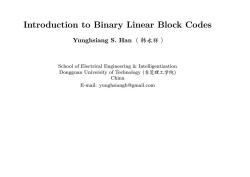
Introduction to Binary Linear Block Codes Yunghsiang s.Han(韩永祥) School of Electrical Engineering Intelligentization Dongguan University of Technology(东莞理工学院) China E-mail:yunghsiangh@gmail.com
Introduction to Binary Linear Block Codes Yunghsiang S. Han (韩永祥) School of Electrical Engineering & Intelligentization Dongguan University of Technology (东莞理工学院) China E-mail: yunghsiangh@gmail.com
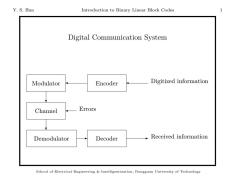
Y.S.Han Introduction to Binary Linear Block Codes Digital Communication System Modulator Encoder Digitized information Channel Errors Demodulator Decoder Received information School of Electrical Engineering Intelligentization,Dongguan University of Technology
Y. S. Han Introduction to Binary Linear Block Codes 1 Digital Communication System Demodulator Channel Modulator Decoder Encoder ❄ ❄ ✛ ✲ ✛ ✲ ✛ Received information Digitized information Errors School of Electrical Engineering & Intelligentization, Dongguan University of Technology
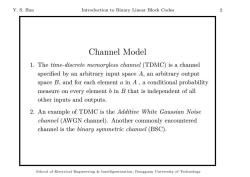
Y.S.Han Introduction to Binary Linear Block Codes 2 Channel Model 1.The time-discrete memoryless channel (TDMC)is a channel specified by an arbitrary input space A,an arbitrary output space B,and for each element a in A,a conditional probability measure on every element b in B that is independent of all other inputs and outputs. 2.An example of TDMC is the Additive White Gaussian Noise channel (AWGN channel).Another commonly encountered channel is the binary symmetric channel(BSC). School of Electrical Engineering Intelligentization,Dongguan University of Technology
Y. S. Han Introduction to Binary Linear Block Codes 2 Channel Model 1. The time-discrete memoryless channel (TDMC) is a channel specified by an arbitrary input space A, an arbitrary output space B, and for each element a in A , a conditional probability measure on every element b in B that is independent of all other inputs and outputs. 2. An example of TDMC is the Additive White Gaussian Noise channel (AWGN channel). Another commonly encountered channel is the binary symmetric channel (BSC). School of Electrical Engineering & Intelligentization, Dongguan University of Technology
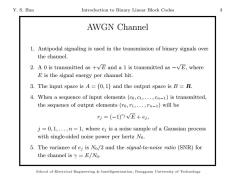
Y.S.Han Introduction to Binary Linear Block Codes 3 AWGN Channel 1.Antipodal signaling is used in the transmission of binary signals over the channel. 2.A 0 is transmitted as +VE and a 1 is transmitted as-vE,where E is the signal energy per channel bit. 3.The input space is A={0,1}and the output space is B=R. 4.When a sequence of input elements(co,ci,...,cn-1)is transmitted, the sequence of output elements (ro,r1,...,rn-1)will be r5=(-1)VE+e, j=0,1,...,n-1,where ej is a noise sample of a Gaussian process with single-sided noise power per hertz No. 5.The variance of ej is No/2 and the signal-to-noise ratio (SNR)for the channel is y=E/No. School of Electrical Engineering Intelligentization,Dongguan University of Technology
Y. S. Han Introduction to Binary Linear Block Codes 3 AWGN Channel 1. Antipodal signaling is used in the transmission of binary signals over the channel. 2. A 0 is transmitted as + √ E and a 1 is transmitted as − √ E, where E is the signal energy per channel bit. 3. The input space is A = {0, 1} and the output space is B = R. 4. When a sequence of input elements (c0, c1, . . . , cn−1) is transmitted, the sequence of output elements (r0, r1, . . . , rn−1) will be rj = (−1)cj √ E + ej , j = 0, 1, . . . , n − 1, where ej is a noise sample of a Gaussian process with single-sided noise power per hertz N0. 5. The variance of ej is N0/2 and the signal-to-noise ratio (SNR) for the channel is γ = E/N0. School of Electrical Engineering & Intelligentization, Dongguan University of Technology
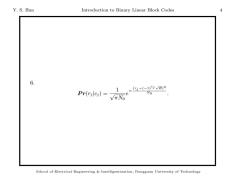
Y.S.Han Introduction to Binary Linear Block Codes 》 6. Pr(rilcj)= 1-g1-(-1)95E)2 -e √πN School of Electrical Engineering Intelligentization,Dongguan University of Technology
Y. S. Han Introduction to Binary Linear Block Codes 4 6. P r(rj |cj ) = 1 √ πN0 e − (rj −(−1)cj √ E) 2 N0 . School of Electrical Engineering & Intelligentization, Dongguan University of Technology
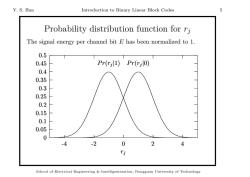
Y.S.Han Introduction to Binary Linear Block Codes 5 Probability distribution function for ri The signal energy per channel bit E has been normalized to 1. 0.5 0.45 Pr(ril1)Pr(ril0) 0.4 0.35 0.3 0.25 0.2 0.15 0.1 0.05 0 -4 -2 0 2 4 Ti School of Electrical Engineering Intelligentization,Dongguan University of Technology
Y. S. Han Introduction to Binary Linear Block Codes 5 Probability distribution function for rj The signal energy per channel bit E has been normalized to 1. 0 0.05 0.1 0.15 0.2 0.25 0.3 0.35 0.4 0.45 0.5 -4 -2 0 2 4 rj P r(rj |1) P r(rj |0) 0 0.05 0.1 0.15 0.2 0.25 0.3 0.35 0.4 0.45 0.5 -4 -2 0 2 4 rj P r(rj |1) P r(rj |0) School of Electrical Engineering & Intelligentization, Dongguan University of Technology
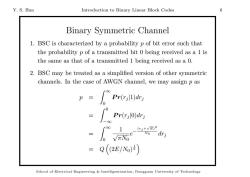
Y.S.Han Introduction to Binary Linear Block Codes 6 Binary Symmetric Channel 1.BSC is characterized by a probability p of bit error such that the probability p of a transmitted bit 0 being received as a 1 is the same as that of a transmitted 1 being received as a 0. 2.BSC may be treated as a simplified version of other symmetric channels.In the case of AWGN channel,we may assign p as ● p= Pr(rill)dri = Pr(ril0)dri 1 (rj+vE)2 ViNGe No drj Q((2E/No) School of Electrical Engineering Intelligentization,Dongguan University of Technology
Y. S. Han Introduction to Binary Linear Block Codes 6 Binary Symmetric Channel 1. BSC is characterized by a probability p of bit error such that the probability p of a transmitted bit 0 being received as a 1 is the same as that of a transmitted 1 being received as a 0. 2. BSC may be treated as a simplified version of other symmetric channels. In the case of AWGN channel, we may assign p as p = ∫ ∞ 0 P r(rj |1)drj = ∫ 0 −∞ P r(rj |0)drj = ∫ ∞ 0 1 √ πN0 e − (rj + √ E) 2 N0 drj = Q ( (2E/N0) 1 2 ) School of Electrical Engineering & Intelligentization, Dongguan University of Technology
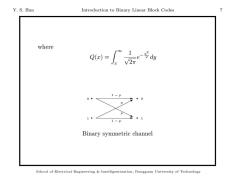
Y.S.Han Introduction to Binary Linear Block Codes where 1-P 0 ·0 p 1. 。1 1-P Binary symmetric channel School of Electrical Engineering Intelligentization,Dongguan University of Technology
Y. S. Han Introduction to Binary Linear Block Codes 7 where Q(x) = ∫ ∞ x 1 √ 2π e − y 2 2 dy ✟✟ ✟✟✟ ✟✯ ❍ ✲ q ❍❍❍❍❍❥ ✲ q q q 1 0 1 0 1 − p 1 − p p p Binary symmetric channel School of Electrical Engineering & Intelligentization, Dongguan University of Technology
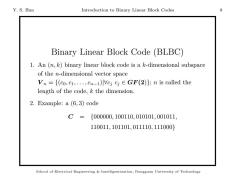
Y.S.Han Introduction to Binary Linear Block Codes 8 Binary Linear Block Code (BLBC) 1.An (n,k)binary linear block code is a k-dimensional subspace of the n-dimensional vector space Vn={(co,c1,...,cn-1)Ivcj cjGF(2)};n is called the length of the code,k the dimension. 2.Example:a (6,3)code C={000000,100110,010101,001011, 110011,101101,011110,111000} School of Electrical Engineering Intelligentization,Dongguan University of Technology
Y. S. Han Introduction to Binary Linear Block Codes 8 Binary Linear Block Code (BLBC) 1. An (n, k) binary linear block code is a k-dimensional subspace of the n-dimensional vector space V n = {(c0, c1, . . . , cn−1)|∀cj cj ∈ GF(2)}; n is called the length of the code, k the dimension. 2. Example: a (6, 3) code C = {000000, 100110, 010101, 001011, 110011, 101101, 011110, 111000} School of Electrical Engineering & Intelligentization, Dongguan University of Technology
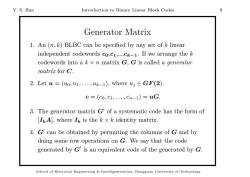
Y.S.Han Introduction to Binary Linear Block Codes 9 Generator Matrix 1.An (n,k)BLBC can be specified by any set of k linear independent codewords co,c1,...,ck-1.If we arrange the k codewords into a k x n matrix G,G is called a generator matrix for C. 2.Letu=(uou1,·,uk-1),where u∈GF(2). c=(co,c1,.,cn-1)=uG. 3.The generator matrix G'of a systematic code has the form of [IkA],where Ik is the k x k identity matrix. 4.G can be obtained by permuting the columns of G and by doing some row operations on G.We say that the code generated by G'is an equivalent code of the generated by G. School of Electrical Engineering Intelligentization,Dongguan University of Technology
Y. S. Han Introduction to Binary Linear Block Codes 9 Generator Matrix 1. An (n, k) BLBC can be specified by any set of k linear independent codewords c0,c1,…,ck−1. If we arrange the k codewords into a k × n matrix G, G is called a generator matrix for C. 2. Let u = (u0, u1, . . . , uk−1), where uj ∈ GF(2). c = (c0, c1, . . . , cn−1) = uG. 3. The generator matrix G′ of a systematic code has the form of [IkA], where Ik is the k × k identity matrix. 4. G′ can be obtained by permuting the columns of G and by doing some row operations on G. We say that the code generated by G′ is an equivalent code of the generated by G. School of Electrical Engineering & Intelligentization, Dongguan University of Technology
按次数下载不扣除下载券;
注册用户24小时内重复下载只扣除一次;
顺序:VIP每日次数-->可用次数-->下载券;
- 西安电子科技大学:《纠错码》课程教学资源(课件讲义)Cyclic Codes.pdf
- 西安电子科技大学:《纠错码》课程教学资源(课件讲义)Decoding BCH/RS Codes.pdf
- 西安电子科技大学:《纠错码》课程教学资源(课件讲义)BCH Codes.pdf
- 西安电子科技大学:《纠错码》课程教学资源(课件讲义)Introduction to Finite Fields.pdf
- 西安电子科技大学:《信息论与编码理论基础》课程PPT教学课件(信息论)第九章 率失真函数.ppt
- 西安电子科技大学:《信息论与编码理论基础》课程PPT教学课件(编码部分)卷积码.pptx
- 西安电子科技大学:《信息论与编码理论基础》课程PPT教学课件(编码部分)循环码.pptx
- 西安电子科技大学:《信息论与编码理论基础》课程PPT教学课件(编码部分)有限域.ppt
- 西安电子科技大学:《信息论与编码理论基础》课程PPT教学课件(编码部分)线性分组码.pptx
- 西安电子科技大学:《信息论与编码理论基础》课程PPT教学课件(编码部分)码纠错能力的判断.ppt
- 西安电子科技大学:《信息论与编码理论基础》课程PPT教学课件(信息论)第五章 信道编码定理.ppt
- 西安电子科技大学:《信息论与编码理论基础》课程PPT教学课件(信息论)第四章 信道及其容量.ppt
- 西安电子科技大学:《信息论与编码理论基础》课程PPT教学课件(信息论)第三章 信源编码(一)离散信源无失真编码.ppt
- 西安电子科技大学:《信息论与编码理论基础》课程PPT教学课件(信息论)第二章 信息量和熵.ppt
- 西安电子科技大学:《信息论与编码理论基础》课程PPT教学课件(信息论)第一章 引论(主讲:孙蓉).ppt
- 西安电子科技大学:《纠错码与差错控制》课程教学资源(PPT课件)第四章 多项式环与有限域.ppt
- 西安电子科技大学:《纠错码与差错控制》课程教学资源(PPT课件)第三章 线性分组码.ppt
- 西安电子科技大学:《纠错码与差错控制》课程教学资源(PPT课件)第二部分 代数引论.ppt
- 西安电子科技大学:《纠错码与差错控制》课程教学资源(PPT课件)第一章 纠错码基本概念(主讲:孙蓉).ppt
- 安徽科技学院:《电子技术》课程教学资源(PPT课件)第二章 基本放大电路.ppt
- 西安电子科技大学:《纠错码》课程教学资源(课件讲义)Introduction to Reed-Solomon Codes[.pdf
- 西安电子科技大学:《通信原理》课程教学资源(课件讲稿)第1章 绪论(主讲:刘龙伟).pdf
- 西安电子科技大学:《通信原理》课程教学资源(课件讲稿)第2章 随机过程.pdf
- 西安电子科技大学:《通信原理》课程教学资源(课件讲稿)第3章 信道与噪声.pdf
- 西安电子科技大学:《通信原理》课程教学资源(课件讲稿)第4章 模拟通信系统.pdf
- 西安电子科技大学:《通信原理》课程教学资源(课件讲稿)第5章 数字基带传输系统.pdf
- 西安电子科技大学:《通信原理》课程教学资源(课件讲稿)第6章 模拟信号的数字传输(1/3)6.1 抽样定理 超链接 6.2 脉冲幅度调制(PAM)超链接.pdf
- 西安电子科技大学:《通信原理》课程教学资源(课件讲稿)第6章 模拟信号的数字传输(2/3)6.3 脉冲编码调制(PCM).pdf
- 西安电子科技大学:《通信原理》课程教学资源(课件讲稿)第6章 模拟信号的数字传输(3/3)6.4 自适应差分脉冲编码调制 6.5 增量调制(△M)6.6 时分复用(TDM).pdf
- 西安电子科技大学:《通信原理》课程教学资源(课件讲稿)第7章 数字频带传输系统.pdf
- 西安电子科技大学:《通信原理》课程教学资源(课件讲稿)第10章 复用和数字复接技术.pdf
- 西安电子科技大学:《通信原理》课程教学资源(课件讲稿)第11章 同步技术.pdf
- 西安电子科技大学:《通信原理》课程教学资源(课件讲稿)第8章 数字信号的最佳接收.pdf
- 西安电子科技大学:《通信原理》课程教学资源(课件讲稿)第9章 现代数字调制解调技术.pdf
- 西安电子科技大学:《通信原理》课程教学资源(辅导资料)ISI.ppt
- 西安电子科技大学:《通信原理》课程教学资源(辅导资料)Viterbi译码.ppt
- 《通信原理》课程教学资源(辅导资料)Selected MIMO Techniques and their Performance.pdf
- 西安电子科技大学:《信号检测与估值》课程教学资源(课件讲稿,2019)第一章 高斯信道上的信号检测.pdf
- 西安电子科技大学:《信号检测与估值》课程教学资源(课件讲稿,2019)第二章 衰落信道上的信号检测.pdf
- 西安电子科技大学:《信号检测与估值》课程教学资源(课件讲稿,2019)第三章 统计信号估计(主讲:郑贱平).pdf
